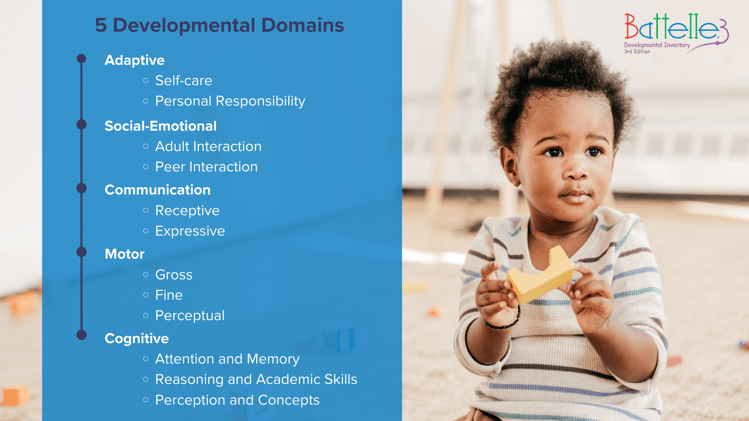Looking Beyond the Standard Score in Childhood Examinations

Beyond Eligibility: How Do I Know if What I’m Doing is Working?
When students take assessments and results come in, our eyes typically key in on the standard scores, scaled scores, and percentile ranks. Those numbers can shed some light on the ability of a given student population, but they aren’t always the most representative of a student’s functioning. Thankfully, assessments like the Battelle Developmental Inventory (BDI-3) provide other metrics that break down individual students’ results into precise indicators of their strengths and weaknesses as well as track their progress year-to-year.
Think of it like this: if you have a student who scores in the 50th percentile overall and you don’t look beyond that percentile, you might assume that the child is average across the board of testing categories. However, digging deeper into the data can reveal specific areas or individual tasks that are strengths or weaknesses, which may be masked if you focus solely on the overall percentile rank. Knowing those specific strengths and weaknesses can help us provide the level of support necessary to enable each child to reach their full potential.
To decipher the technical details in the BDI-3 and how it can serve teachers in their work with individual students, we held a webinar with Dr. Catherine Perkins, who has decades of experience in school psychology and counseling, with an expertise in early childhood development.
For starters, the BDI-3 is based on the concept of developmental milestones and breaks down into five developmental domains, each with a few subdomains:

Dr. Perkins suggests paying attention to the subdomain scores, particularly the Relative Developmental Index (RDI) and Change Sensitive Score (CSS). Don’t let the technical terms scare you – they’re quite friendly scores and here to help!
Relative Developmental Index (RDI)
The Relative Developmental Index (RDI) is a reflection of a student’s proficiency within a subdomain where an RDI of 90/90 is average among same age peers. Performance can be broken down into the following categories:
96-100/90 – Independent 76-95/90 – Emerging <75/90 – Frustration
Let’s say we’re looking at the Motor domain, and the student’s performance fell within the average range according to the overall standard score in this domain. Examining the RDI for each of the Gross, Fine, and Perceptual subdomains, we discover that while the student earned a RDI of 90/90 and 85/90 on the Gross Motor and Perceptual Motor subdomains, their RDI for the Fine Motor subdomain was 50/90. This would indicate that while the student demonstrates adequate proficiency in gross and perceptual motor skills, they need significant work on their fine motor skills in order to get them up to speed with their peers.
Think of RDI as a highlighter that help teachers hone in on specific areas of need that don’t necessarily get flagged in the broader standard scores but can identify skills where teachers can provide students with the specified lift that they deserve in order to thrive.
Change Sensitive Score (CSS)
The Change Sensitive Score (CSS) monitors student progress longitudinally, or periodically over time. While RDI assesses the student’s proficiency on skills measured by a particular subdomain within the most recent assessment, the CSS tracks student performance in subdomains from past assessments in relation to the most recent one.
As Dr. Perkins says, “It accounts for every item the child can do today that they couldn’t do yesterday.”
CSS is especially helpful in understanding students’ scores when they achieve a lower standard score than they did the previous year or assessment period. Dr. Perkins notes that standard scores take the rate of acquisition into consideration, meaning that if the average student learns at a faster rate, the below-average student who learns at a slower rate can look worse off than they did the year before.
However, that’s when you can turn to the CSS score. Comparing the current CSS to the previous CSS can show how the individual student’s performance changed. If the scores went up, the student is still progressing, it’s just at a slower rate than their peers. As Dr. Perkins says, "this score can be particularly helpful when talking through results with parents because it can show that progress is being made, which can put their minds at ease "
The BDI-3 scores can also serve as benchmarks in making service plans for students. Long-term goals can include subdomain skill acquisition as specific goals, and the individual tasks within those subdomains can be the short-term objectives. The evaluation criteria and instructional materials are embedded and identified in the individual tasks as well, which provides a clear instructional roadmap for teachers.
In short, break away from the standard scores, embrace your new friends RDI and CSS, incorporate them into your assessment and planning practices to individualize instruction, and help every student thrive!



%20-%20Dr.%20Welch%20.png?width=900&name=Drive%20Student%20Growth%20(blog%20header)%20-%20Dr.%20Welch%20.png)
-1.png)